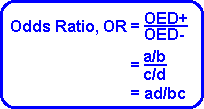 |
| Block 1: Epidemiology |
| EPI.4-1: THE ODDS RATIO |
 |
| Block 1: Epidemiology |
| EPI.4-1: THE ODDS RATIO |
SESSION OBJECTIVE |
|
At the end of this session you should be able to understand the Odds Ratio as a measure of effect and what it estimates. You should also be able to calculate it from data. |
Note that the Odds Ratio has no easily usable counterpart as a measure of occurrence.
It is used in a case-control design study where one has to work backwards from a given number of cases and controls to the probability of exposure, rather than directly measure the probability of disease (measure of occurrence).
Remember the definition:

| D+ | D- | ||
| E+ | a | c | M1 |
| E- | b | d | M0 |
| N1 | N1 | T |
The odds of exposure in the diseased (OED+) is given by

Similarly, the odds of exposure in the non-diseased (OED-) is

Hence
